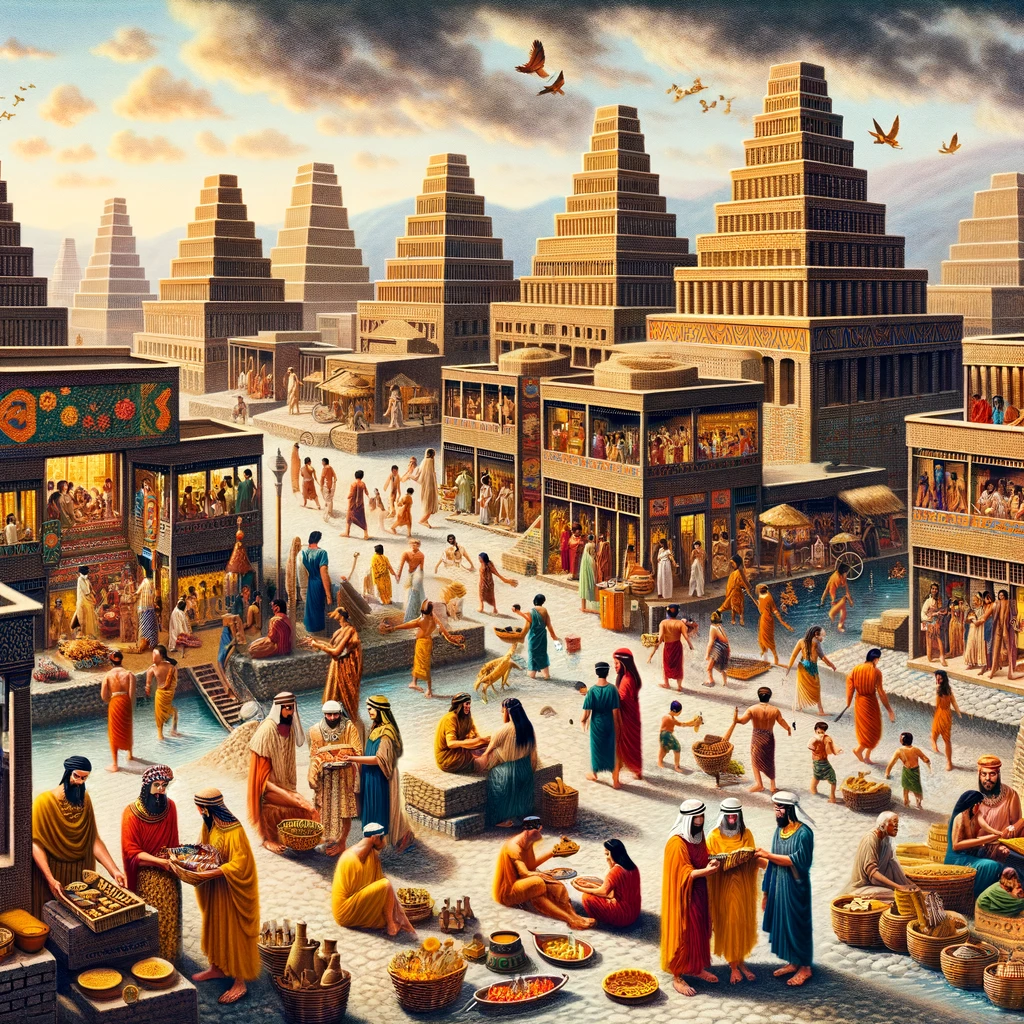let’s take a trip back to the wild and wacky world of ancient Mesopotamia, where social status was everything, and your place in the hierarchy determined pretty much your entire existence. Buckle up, ’cause this ain’t your typical history lesson.
The Royal Fam: Living Large and In Charge
At the top of the food chain, we had the king and his royal entourage. These dudes were living the high life, basking in luxury and power. Imagine walking around decked out in the finest threads, adorned with glittering jewels, and being treated like a straight-up deity. Talk about a sweet gig!
But being king wasn’t all fun and games – these guys had to keep a tight grip on their empire, which meant making tough decisions and dealing with all sorts of drama. From settling disputes to leading armies into battle, the king’s life was a constant balancing act of maintaining order and keeping the masses in check.
The Nobles: A Classy (and Sassy) Bunch
Just a rung below the royals, we had the noble class – a sophisticated crew of wealthy landowners, high-ranking officials, and military hotshots. These folks lived in the lap of luxury, enjoying all the finer things in life, like fancy villas, lavish parties, and the latest fashion trends (you know, if you consider loincloths and woven robes the height of fashion).
Now, the nobles were a sassy bunch, always looking to one-up each other and flex their social status. They’d throw epic bashes, commission grandiose artworks, and even dabble in a bit of backbiting and gossip – because what’s a high society without a little drama?
| Social Class | Perks |
|---|---|
| Royalty | Absolute power, lavish palaces, servants galore |
| Nobles | Wealth, land ownership, leisure time |
| Merchants | Exotic goods, international connections |
| Craftsmen | Respected trades, potential for prosperity |
| Peasants | At least they had each other. |
The Merchants: Globetrotters and Wealthy Wanderers
Now, let’s talk about the real movers and shakers of ancient Mesopotamia – the merchants! These savvy businessmen were the ultimate globetrotters, traveling far and wide to trade exotic goods like spices, precious metals, and the latest fashion trends (yeah, those loincloths were all the rage).
While they might not have had the same social clout as the nobles, the merchants were rolling in dough – and in those days, money talked louder than a donkey with a megaphone. They lived in swanky homes, dressed to the nines, and rubbed elbows with the upper crust, thanks to their deep pockets and international connections.
The Craftsmen: Respected Tradesmen with a Touch of Flair
Next up, we’ve got the craftsmen – a hardworking bunch of artisans, metalworkers, potters, and everything in between. These skilled tradesmen were the lifeblood of Mesopotamian society, creating all sorts of functional (and sometimes not-so-functional) goods that kept the wheels turning.
While they might not have been swimming in riches like the merchants, the craftsmen enjoyed a decent standard of living and a whole lot of respect. After all, who doesn’t appreciate a finely crafted ceramic bowl or a killer set of bronze tools? Plus, these guys had a real artistic flair, infusing their creations with intricate designs and mythological motifs that would make modern-day hipsters green with envy.
The Peasants: The Backbone of Society (and the Butt of All Jokes)
Last but certainly not least, we’ve got the peasants – the salt of the earth, the backbone of Mesopotamian society. These hardworking folks toiled away in the fields, tending to crops, herding livestock, and generally doing all the dirty work that kept the entire civilization afloat.
Now, life as a peasant wasn’t exactly a walk in the palace gardens. Long hours, backbreaking labor, and a diet consisting mostly of gruel and the occasional vegetable made for a pretty rough existence. At least they had each other, right? And who doesn’t love a good old-fashioned peasant joke to lift the spirits?
Daily Grind: A Peek into the Lives of the Common Folk
Alright, so we’ve covered the social ranks, but what about the nitty-gritty of daily life? Let’s take a closer look at how the average Joe (or should we say, Joe-seph?) spent their days in ancient Mesopotamia.
For the peasants and lower-class workers, the daily grind was no joke. Up before the crack of dawn, they’d toil away in the fields, tending to crops, herding sheep, or working in the city as laborers, hauling bricks, and building those iconic ziggurats (talk about a killer workout!).
Meanwhile, in the cities, the streets would come alive with a flurry of activity. Merchants would haggle over prices in the bustling markets, craftsmen would ply their trades in their workshops, and scribes would furiously scratch away at their clay tablets, recording everything from legal contracts to epic tales of adventure.
And let’s not forget the domestic sphere, where women played a crucial role in keeping households running smoothly. From grinding grain and baking bread to weaving textiles and caring for children, these ladies were the true MVPs of ancient Mesopotamian society.
Leisure Time: How the Other Half Lived
Of course, while the common folk were busy breaking their backs, the upper crust had a little more time for leisure and recreation. The nobles and royals would indulge in all sorts of fancy pastimes, like banqueting, hunting, and even a spot of good old-fashioned chariot racing (eat your heart out, Ben-Hur!).
Artistic pursuits were also a favorite among the elite, with poets, musicians, and scribes being commissioned to create works that celebrated the glory of the king and the grandeur of Mesopotamian culture. Talk about a cushy gig!
But even the lowly peasants found ways to kick back and enjoy themselves when they could. Simple pleasures like sharing stories, playing games, and partaking in religious festivals provided a much-needed respite from the daily grind.
Religion and Superstition: The Glue That Held It All Together
No discussion of ancient Mesopotamian life would be complete without touching on the role of religion and superstition. These folks took their gods and goddesses very seriously, with each city-state having its pantheon of deities to worship and appease.
From grand temples and elaborate rituals to omens, curses, and all sorts of mystical mumbo-jumbo, religion permeated every aspect of Mesopotamian society. The priests and priestesses were highly respected figures, acting as intermediaries between the common folk and the divine realms.
And let’s not forget about all those wacky superstitions! From wearing amulets for protection to consulting oracles before making important decisions, the people of ancient Mesopotamia left no stone unturned when it came to keeping supernatural forces at bay.
The Takeaway: A Vibrant Tapestry of Social Stratification
So, there you have it, folks – a crash course in the wild and wacky world of ancient Mesopotamian social hierarchy and daily life. From the pampered royals to the hard-working peasants, each rank played its part in shaping this fascinating civilization.
But beneath all the glitz and glamour (or lack thereof), there was a rich tapestry of cultural traditions, artistic expression, and religious fervor that bound these diverse social strata together. It might not have been a perfect system, but hey, at least they knew how to throw a killer party and tell a good story!
CONCLUSION
So, the next time you’re feeling down about your place in the world, just remember – at least you’re not a Mesopotamian peasant, hauling bricks in the scorching sun. Count your blessings, my friends, and embrace the quirky charm of our ancient ancestors’ way of life.

